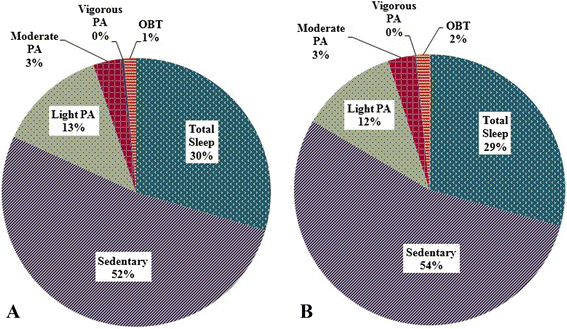Adherence to physical activity guidelines in mid-pregnancy does not reduce sedentary time: an observational study
- PMID: 25879428
- PMCID: PMC4345024
- DOI: 10.1186/s12966-015-0191-7
Adherence to physical activity guidelines in mid-pregnancy does not reduce sedentary time: an observational study
Abstract
Background: Physical activity (PA) interventions designed to prevent prenatal complications have focused on increasing moderate PA yielding conflicting results. Minimal attention has focused on the evaluation of sleep, sedentary behavior (SB), light activity or total daily PA during pregnancy. The purpose of this prospective, longitudinal study was to 1) objectively quantify and compare habitual PA and SB during the 2nd and 3rd trimester; and 2) evaluate differences in activity patterns for women meeting prenatal PA guidelines versus those that did not.
Methods: Forty-six participants wore 2 PA monitors (SenseWear Mini and activPAL) during week 18 and week 35 of pregnancy. We compared differences in sleep duration, postural allocation, daily steps, and PA between the 2nd and 3rd trimester and for women who met and did not meet PA guidelines.
Results: During the 2(nd) trimester, 30% of the women's day (24-hours) was total sleep; 52% SB; 13% light; 3% moderate; and 0% vigorous PA. Light (P = 0.05), vigorous (P = 0.02), and moderate-vigorous PA (MET-minutes; P = 0.02), decreased with a trend in increased SB (P = 0.07). Activity of other intensities and sleep duration did not significantly change. Only 39% and 37% of participants slept between 7-9 hours/night at week 18 and 35, respectively. Forty-six percent (n = 21) and 28% (n = 13) of participants met prenatal PA guidelines during the 2(nd) and 3(rd) trimester, respectively. At week 18, no differences in total sleep, SB, or light PA existed for women who met PA guidelines versus those who did not; total PA was significantly greater for women who met guidelines. At week 35, women that met PA guidelines had significantly less SB (P < 0.005) than women who did not.
Conclusions: This study demonstrates that pregnant women spend the majority of their day in SB. Significant reductions in total activity across pregnancy may be attributed, in part to shifts in light PA and increased SB. Based on the lifestyle of our sample, regardless of meeting PA guidelines in mid-pregnancy, no significant difference exists in time spent in SB, however meeting PA recommendations in late pregnancy may reduce SB. Future interventions should target reducing SB by increasing light and moderate PA beyond volitional exercise.
Figures


Similar articles
-
Trends and correlates of meeting 24-hour movement guidelines: a 15-year study among 167,577 Thai adults.Int J Behav Nutr Phys Act. 2020 Aug 24;17(1):106. doi: 10.1186/s12966-020-01011-9. Int J Behav Nutr Phys Act. 2020. PMID: 32838796 Free PMC article.
-
Which Women are Highly Active Over a 12-Year Period? A Prospective Analysis of Data from the Australian Longitudinal Study on Women's Health.Sports Med. 2017 Dec;47(12):2653-2666. doi: 10.1007/s40279-017-0732-0. Sports Med. 2017. PMID: 28477211
-
Physical Activity and Sedentary Behavior Patterns Before and During Pregnancy in a Multi-ethnic Sample of Asian Women in Singapore.Matern Child Health J. 2015 Nov;19(11):2523-35. doi: 10.1007/s10995-015-1773-3. Matern Child Health J. 2015. PMID: 26140834
-
Scoping Review of Population-Based Physical Activity and Sedentary Behavior in Saudi Arabia.J Phys Act Health. 2023 Apr 25;20(6):471-486. doi: 10.1123/jpah.2022-0537. Print 2023 Jun 1. J Phys Act Health. 2023. PMID: 37185448
-
Smartphone-Based Interventions to Reduce Sedentary Behavior and Promote Physical Activity Using Integrated Dynamic Models: Systematic Review.J Med Internet Res. 2021 Sep 13;23(9):e26315. doi: 10.2196/26315. J Med Internet Res. 2021. PMID: 34515637 Free PMC article.
Cited by
-
Effects of Two Physical Activity Interventions on Sleep and Sedentary Time in Pregnant Women.Int J Environ Res Public Health. 2023 Mar 31;20(7):5359. doi: 10.3390/ijerph20075359. Int J Environ Res Public Health. 2023. PMID: 37047973 Free PMC article. Clinical Trial.
-
A Delphi Study to Identify Research Priorities Regarding Physical Activity, Sedentary Behavior and Sleep in Pregnancy.Int J Environ Res Public Health. 2022 Mar 2;19(5):2909. doi: 10.3390/ijerph19052909. Int J Environ Res Public Health. 2022. PMID: 35270601 Free PMC article.
-
Physical activity and sedentary time during pregnancy and associations with maternal and fetal health outcomes: an epidemiological study.BMC Pregnancy Childbirth. 2021 Feb 27;21(1):166. doi: 10.1186/s12884-021-03627-6. BMC Pregnancy Childbirth. 2021. PMID: 33639879 Free PMC article.
-
Lifestyle and the hypertensive disorders of pregnancy in nulliparous women in the United States: a secondary data analysis of the nuMom2b.BMC Pregnancy Childbirth. 2023 Mar 23;23(1):201. doi: 10.1186/s12884-023-05522-8. BMC Pregnancy Childbirth. 2023. PMID: 36959650 Free PMC article.
-
Compliance with 24 h Movement Behavior Guidelines for Pregnant Women in Saudi Arabia: The Role of Trimester and Maternal Characteristics.Healthcare (Basel). 2024 Oct 15;12(20):2042. doi: 10.3390/healthcare12202042. Healthcare (Basel). 2024. PMID: 39451457 Free PMC article.
References
Publication types
MeSH terms
LinkOut - more resources
Full Text Sources
Other Literature Sources
Medical
Miscellaneous

